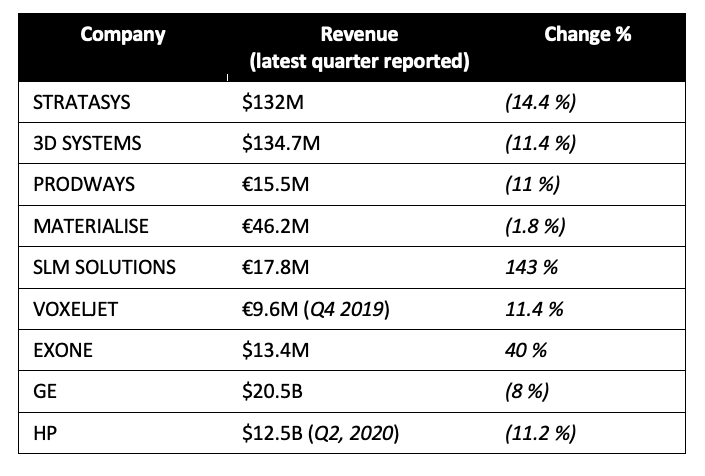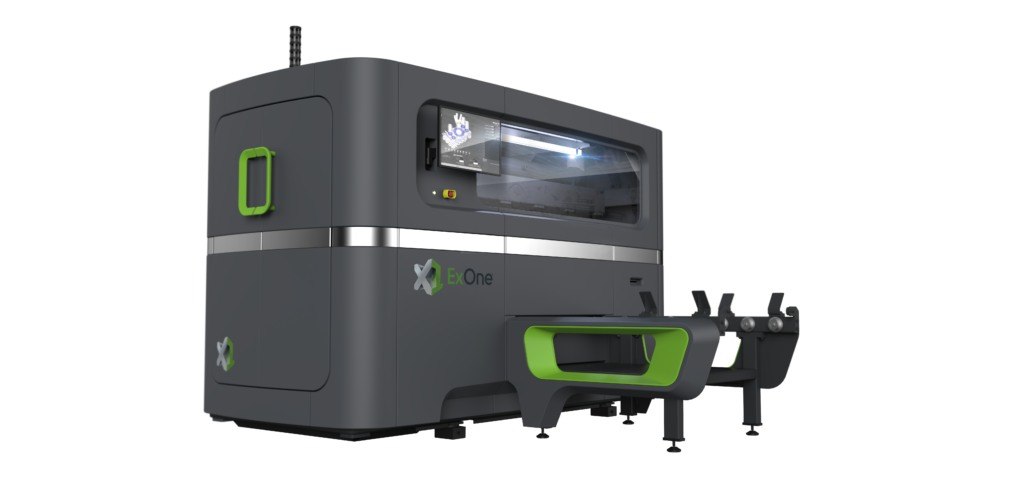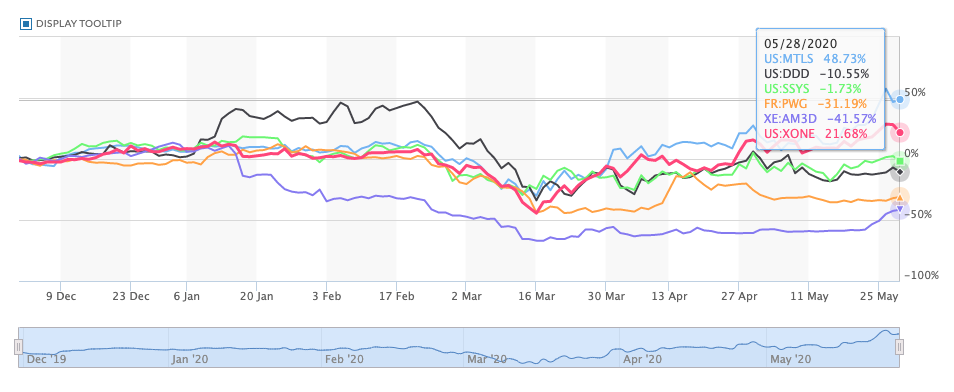Voodoo Manufacturing shuts down permanently amid pandemic
Win a $3,999 Craftbot Flow IDEX XL 3D printer in the 3D Printing Industry Awards trophy design competition
Materialise Q2 2020 revenue declines by more than 20 percent despite software growth
The ten additive manufacturing experts receiving AMUG’s 2020 DINO Awards
3D printing industry news sliced: EOS, ExOne, Materialise, Essentium, Relativity Space, PrintLab, 3D Printz, and more
Researchers determine 3D printing more effective in treating hip fractures
COVID-19 Doesn’t Shake Reinforced Optimism of 3D Printing Businesses
Recent announcements regarding earnings and financial performance through the first quarter of 2020, have given some insight into the impact COVID-19 has had on major 3D Printing businesses worldwide.
While ensuring employee safety and business continuity remained paramount, public companies were simultaneously challenged by a sudden decline in consumer demand, a continuing halt or reduction in onsite activities, and global supply chain issues, which began in China shortly before impacting Europe and the Americas.
Revenues for Stratasys and 3D Systems declined by 14% and 11% respectively, whereas strong order backlogs from 2019 led to significantly higher revenues realized for SLM and ExOne. SLM had the best first quarter performance in the company’s history with a 143% increase compared to 2019.
3D Systems saw revenues decline across segments, except materials, which stayed flat. The company faced a drop in consumer demand in automotive, aerospace, healthcare and dental, as well as disruptions in production facilities and on-site services. Despite sustained cost reduction measures and improving operating expenses by 13%, its shares depreciated 5% with 0.04 loss per share for 2020, compared to 0.09 loss per share for 2019.
In addition to the decline in Q1, Stratasys expects a sequential decline in Q2 of 5-10%. Yet the company believes its balance sheet with $325M in cash, coupled with its ability to generate cash and control costs, will help it manage the short-term hit in revenues, and strongly expects margins to recover.
Across businesses, revenue decline has primarily been attributed to short-term impact of reduced manufacturing activity and industrial production due to COVID-19, resulting in a fall in consumer demand across segments. In addition, a pause and postponement of investment has seen lower capex spend across key industries such as automotive, aerospace, healthcare and oil & gas. Demand for new hardware and software licenses has declined, partly offset by recurring revenues from materials, consumables, or after-sales services. In some sectors, such as dental, material consumption has slowed as elective procedures are delayed or cancelled. In general, machine and software segment revenues have seen a decline, but recurring revenues from the installed base of 3D printers has seen revenues from the materials segment increase or stay flat. For instance, Prodways saw a decrease of 6.3% in machines and software, but a 25% increase in materials revenues.
This change in demand is seen as more of a ‘pushing-out’ of capex spend, than a cancellation. Order intakes stayed flat or reduced overall, as customers in key industries postponed capital expenditure and investment due to COVID-19 uncertainty and impact.
The impact in operations differed, as businesses with localized supply chains were less impacted—such as SLM who also kept safety stocks for high-risk and long-lead time items—as compared to 3D Systems or HP, who faced production and capacity disruptions in their global supply chains.

The NIP mask, developed by Materialise to help treat COVID-19 patients. Image courtesy of Materialise.
Materialise saw a slight revenue decrease of 1.8% with gross profits decreasing 3.7% compared to last year’s quarter. Though their software and medical segments grew, there was a steeper decline in their manufacturing segment revenues, which account for 45% of total revenue. The company delivered higher than expected revenues this quarter with a gross profit of $109M, and despite varied market performance recently, has seen its shares up 25.4% year to date.
ExOne, sold 14 of its metal and sand binder jetting machines in the quarter, with a 40% increase in revenues and a 19% improvement in net loss with $3.6M in Q1 2020, resulting in a $0.22 loss per share for 2020 compared to $0.28 in 2019.
Revenues at GE Group fell 8% to $20.5B, with is power and aviation division significantly impacted by its exposure to the decline in the commercial aerospace sector. However, GE’s Healthcare and Lifesciences segment saw demand surge 6% due to COVID-19. Yet the company has seen its shares lose more than 40% of their value this year and expects the second quarter results to decline sequentially, showing the first full quarter impact from COVID-19.
HP Inc has reported second quarter results with net revenues were down 11.2% to $12.5B compared to 2019, with personal systems declining 7% and printing 19%. In Printing, the company has set long term margin targets of 16-18%. In 3D Printing, HP has recently partnered with New Balance and Superfeet to grow its end-user solutions in scanning and printing, and is counting on key verticals such as healthcare for continued growth. The company is continuing its focus on structural cost optimization and productivity gains, hoping to generate over $2B in savings. It has also provided guidance of $2.33-2.43 per share for 2020 and $3.25-3.65 per share for 2022.
Voxeljet’s share price has reduced dramatically over the last five years, despite steadily growing revenues. It has until December, 29, 2020 to regain compliance with NYSE after its average closing share price had fallen below $1.00 standard and the $50M market capitalization standard. Yet the company has reported Q4 2019 revenues with an 11.4% increase over 2018, and a record order backlog. While it does expect disruptions in operations and supply chain due to COVID-19, it anticipates demand for its large-scale printers to continue, expecting annual revenue for 2020 to be between €25-30M.
Companies have also been proactive within their organization to manage the impact of the crisis to their employees, customer base and business operations. From introducing remote working, reduced work week or shifts, and other employee-facing policies, to implementing safety and health protocols, freezing non-essential hiring and travel, and short-term optimization measures to ensure business continuity and avoid large-scale layoffs. For instance, salaries for all Stratasys employees and executives was reduced by 20%. Executives and board members at 3D Systems took a 10% pay cut with a majority of employees on limited furloughs, and partial activity measures were introduced for almost 50% of Prodways employees worldwide. Businesses have also taken measures to optimize operational costs, revaluate their supply chain and production costs, and increase focus and spend in digital, particularly in sales and marketing, for the long-term.
Overall, while Q1 earnings do show some signs of business impact, businesses are pointing towards Q2 as to where the full impact will be seen, since the pandemic peaked largely in the latter half of the first quarter, through March and April. In this regard, businesses have trended toward withdrawing guidance for the rest of the year, as uncertainties due to COVID-19 continue, while stating that second quarter results are expected to show a more considerable impact. Although there is a near-term focus on cost reduction, optimization and ensuring liquidity, 3D printing businesses are positive in their long-term outlook. Key industries are expected to remain structurally unaffected, with markets returning to the new normal in the second half of this year, and AM’s increased relevance has reinforced optimism in the industry’s long-term growth. No major shifts in long-term strategy or investment have been made yet due to COVID-19, with investments in on-going R&D continuing.
With their real-time response and contribution during COVID-19, 3D Printing businesses have led the way and impacted the front-line pandemic response, providing rapid, direct support for personnel safety and in essential medical devices and equipment. The response also proved AM’s capability in high-volume and bridge production, its potential in localizing and distributing manufacturing, flexibly and at speed, whether to retool or expand existing production, or to develop new, improved products faster, especially in healthcare. If anything, the pandemic response has only underlined the critical and long-term value of AM in addressing real-world gaps and needs, in ways that traditional manufacturing and supply chains just cannot.
The post COVID-19 Doesn’t Shake Reinforced Optimism of 3D Printing Businesses appeared first on 3DPrint.com | The Voice of 3D Printing / Additive Manufacturing.
3D printing industry news sliced: Formnext, America Makes, 3D Systems, Kingsbury, Amaero, Farsoon and more
3D Printing and COVID-19, May 2, 2020 Update
Companies, organizations and individuals continue to attempt to lend support to the COVID-19 pandemic supply effort. We will be providing regular updates about these initiatives where necessary in an attempt to ensure that the 3D printing community is aware of what is being done, what can be done and what shouldn’t be done to provide coronavirus aid.
Swiss creative agency Atoll, in partnership with Pragma Engineering and 3D printing company Rapid Manufacturing, has designed a device that can be used to remove protective gloves in a way that is less likely to spread contamination. According to one study, almost 50 percent of people contaminate their skin with germs when removing protective clothing.
Atoll’s device is made up of a curved piece of plastic that can be mounted on walls or metal bars over a garbage can using a modular fastening system. Glove wearers are meant to slide the tip of the device between their palms and the cuffs of their gloves. As they pull upward, the gloves fall off and into the bin below. The 3D printable file is located at the Atoll website here.
Members of the AM business community are publishing their quarterly financial results, which include the impacts of the economic slowdown on their finances. Materialise announced its first quarter results, ending March 31, 2020. Renveues dropped 1.8 percent to €46.2 million, from €47.1 million in Q1 2019. Revenue growth continued in its Software (+5 percent, to €9.8 million) and Medical (+15.3 percent to €15.6 million) segments, which was offset by a decrease in its Materialise Manufacturing (-13.9 percent to €20.8 million) segment decreased compared to the same period last year. Executive Chairman Peter Leys commented:
“Fiscal 2020 began with unexpected challenges for businesses worldwide as a result of the COVID-19 virus. Materialise still performed relatively well during the first quarter as sales began to be negatively impacted only towards the end of the quarter. With the subsequent spread of the COVID-19 crisis and the increased disruption to the global economy and normal business operations, we expect the pandemic’s impact to be much more pronounced during at least the second quarter of 2020.”
Leys attributed the shrinkage of the company’s manufacturing division to the impact of the virus outbreak on its ACTech subsidiary, a full-service manufacturer of complex metal parts. Leys said that ACTech is over 80 percent exposed to the automotive industry, compared to its broader manufacturing division which Leys performed “very well, and even in spite of our traditional business also being hit by the COVID crisis towards the end of March actually did better than the first quarter of 2019.”

The NIP mask, developed by Materialise to help treat COVID-19 patients. Image courtesy of Materialise.
Materialise Fried Vancraen noted: “While we do not expect our industry to grow exponentially during this crisis, or shortly thereafter, we are picking up many signals that this crisis, however devastating it may be for those who are personally affected is putting industry 4.0 initiatives in general, and in particular, higher on the agendas.”
Prodways Group of France also reported its financial earnings for the first quarter of 2020, which included an 11 percent decrease in total revenue from Q1 2019 €15.5 million. Revenue generated from design and manufacturing dropped 19.6 percent to €5.6 million from Q1 2019. Software, 3D printers, and related materials and services were down 6.3 percent to €9.8 million.
GE Group revenues dropped 8 percent to $20.5 billion, with total orders decreasing by 5 percent to $19.5 billion. Revenues fell 13 percent in its power and aviation division, which the company naturally associated with the dramatic decline in commercial aerospace caused by the spread of the virus. In turn, CEO Larry Culp, said that the company will be cutting costs:
“We are targeting more than $2 billion in operational cost out and $3 billion of cash preservation to mitigate the financial impact, and we executed a series of actions to de-risk and de-lever our balance sheet amid a challenging environment.”
voxeljet AG received a notice of noncompliance from the New York Stock Exchange due to the fact its average closing price fell below $1.00 per share over 30 consecutive trading days. Due to the pandemic, voxeljet was given an extension to comply with NYSE requirements and has until December 29, 2020, and May 4, 2021, to regain compliance with the $1.00 minimum share price standard and the $50 million market capitalization standard, respectively.
HP Inc.’s net revenue was down 0.6 percent to $14.6 billion compared to last year, according to its earnings report published in February. Protolabs’ revenue actually increased 1.46 percent to $115,108,000. Stratasys has scheduled its Q1 earnings call for May 14. 3D Systems’ call will take place on May 6. SLM Solutions has scheduled its report for May 7.
Meanwhile, Volkswagen Passenger Cars has returned to production, building Golf, Tiguan, Touran and SEAT Tarraco vehicles at the company’s Wolfsburg plant, where VW’s 3D printing center is located. 8,000 employees will work one-shift at a time with reduced contact between one another. About 2,600 suppliers, most of which are in Germany, are also operating to make parts for Volkswagen’s main plant. Roughly 1,400 vehicles are expected to be completed by the end of the first week of resumed production before quantities are increased to over 6,000 in the coming weeks (or about 40 percent of pre-COVID production levels), as multiple shifts are reintroduced.
In order to return to work, the company is instituting a 100-point plan that includes rules related to distancing and hygiene, including home temperature-taking for workers and performing a daily health checklist. Where distances of 1.5 meters are not possible, workers must wear mouth and nose protection. Mobile plexiglass partitions and more handwashing sites have been setup throughout buildings, while conference rooms are converted into office spaces.
As illustrated, businesses globally are being impacted by economic shutdowns. In turn, there may be some potentially positive effects on our ecosystem in the near-term, with the International Energy Agency predicting an 8 percent decrease from last year in global carbon dioxide emissions, the largest recorded drop since the global financial crisis of 2008.
However, IEA Executive Director Dr. Fatih Birol warned that this reduction in CO2 should not be celebrated for a variety of reasons, not the least of which is the dramatic loss of life and increase in suffering that has resulted from the COVID-19 outbreak. Birol told The New York Times:
“This historic decline in emissions is happening for all the wrong reasons. People are dying and countries are suffering enormous economic trauma right now. The only way to sustainably reduce emissions is not through painful lockdowns, but by putting the right energy and climate policies in place.”
There have been nearly a quarter-of-a-million deaths from COVID-19, including nearly 64,000 in the U.S. alone. Over 26.5 million people in the U.S. applied for unemployment within a medical system of appalling inequality, with potentially 8.9 to 13.9 million locked out of unemployment aid altogether. The toll that the virus and economic hardship has had on individuals highlights the fact that economic degrowth cannot come at the expense of human suffering.
Additionally, such dips in emissions as occurred during the 2008 financial crisis are typically followed by emission booms, as economic activity restarts. Moreover, nations such as the U.S. are using the crisis to relax environmental regulations, which can result in greater emissions and other ecological hazards. Therefore, it’s important to be mindful of the human response to the crisis from a global, institutional and individual perspective.
While VW may be able to return to production, we have to wonder about the cost, for instance, on individual workers. Despite the myriad protections in place, what are the assembly line operators exposed to working on the line that the executive class of the corporate group are not exposed to working from home? As manufacturing is ramped up, what does the roll out of new vehicles mean for the larger ecosystem already experiencing collapse?
As the pandemic continues to grip the world, we will continue to provide regular updates about what the 3D printing community is doing in response. As always, it is important to keep safety in mind, remain critical about the potential marketing and financial interests behind seemingly good humanitarian efforts from businesses, and to do no harm.
The post 3D Printing and COVID-19, May 2, 2020 Update appeared first on 3DPrint.com | The Voice of 3D Printing / Additive Manufacturing.




